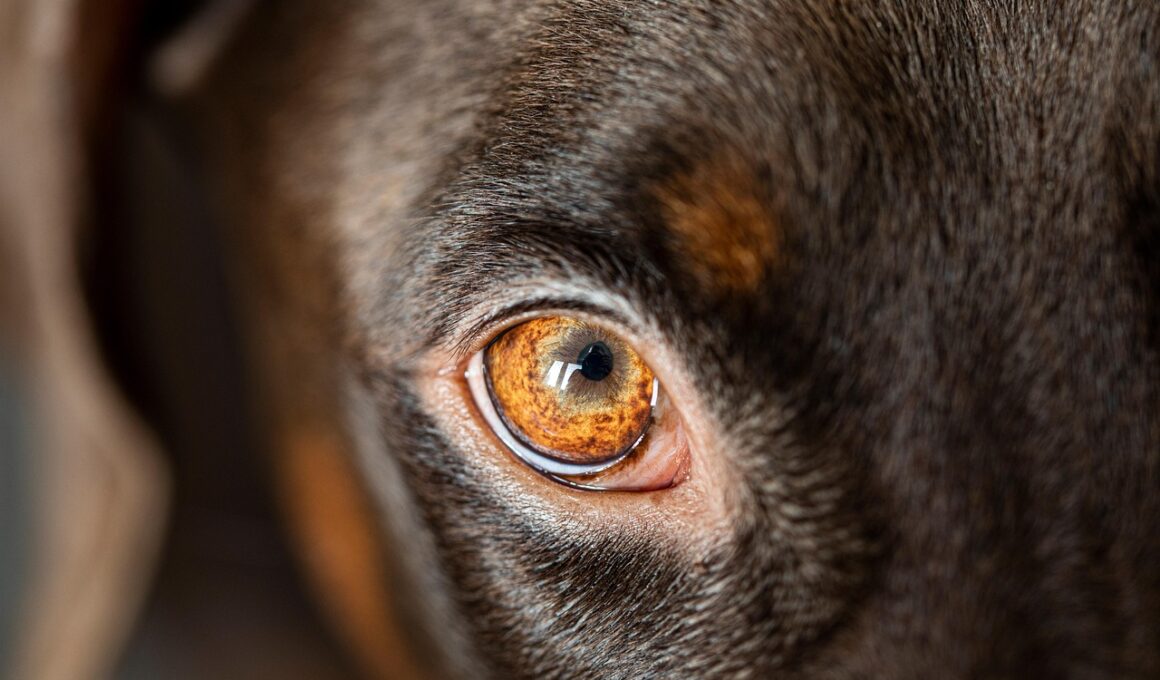Eye Conditions Common in Adopted Dogs and How to Treat Them
When you adopt a dog, understanding their health is crucial. Eye conditions are unfortunately common in these dogs and can lead to discomfort and severe issues if untreated. Some prevalent conditions include cataracts, conjunctivitis, and dry eye syndrome. These issues can stem from genetics, previous injuries, or poor health management prior to adoption. Signs of potential health issues may include excessive tearing, sensitivity to light, or swelling around the eyes. Early recognition of these symptoms is essential. Adoptive dog parents should be diligent in looking for tell-tale signs. Regular check-ups with canine ophthalmologists can help to catch issues early and determine appropriate treatments. Cataracts, often seen in older dogs, can lead to blindness if left untreated. Targeted treatments vary based on the eye condition. For example, fighting conjunctivitis may involve antibacterial eye drops, while surgery might be necessary for cataract removal. Each dog’s needs will differ, making personalized veterinary attention critical. Educated and proactive care will enhance the overall wellbeing of adopted dogs and ensure a bright future.
Another common issue that newly adopted dogs may face is dry eye syndrome, clinically known as keratoconjunctivitis sicca. This debilitating condition arises when a dog’s tear glands fail to produce enough moisture, leading to eye irritation and inflammation. Symptoms such as red eyes, persistent squinting, and a thick discharge will often appear. Treatment for dry eye often involves the use of medicated eye drops that stimulate natural tear production, along with artificial tears to provide comfort. A veterinarian’s input is essential in developing a treatment plan tailored to the individual dog’s needs. If untreated, dry eye syndrome can cause progressive damage to the cornea, potentially resulting in blindness. Veterinary follow-ups are vital, as consistent monitoring ensures that treatments remain effective. Regular eye examinations can help identify other underlying health issues that may exacerbate dry eyes. Pet owners should remain informed on their dog’s health by observing any changes. Maintaining a daily care routine that includes eye care can significantly improve quality of life for a dog affected by this condition. This will allow a newly adopted dog to enjoy their happy life free of discomfort.
Understanding Cataracts in Dogs
Cataracts are another prevalent condition in adopted dogs, primarily seen in older breeds. A cataract affects the eye’s lens, leading to cloudiness that can obstruct vision entirely if not addressed swiftly. Symptoms often develop gradually but can include noticeable changes in vision, such as bumping into objects or hesitance when navigating stairs. If cataracts are suspected, owners should consult a veterinarian for a proper diagnosis. Treatments may range from observation in mild cases to surgical intervention in more serious cases. Fortunately, cataract surgery in dogs is relatively straightforward and can restore vision effectively. Post-operative care is typically crucial and may include eye drops or scheduled follow-up visits. Preventative measures include regular vet check-ups that can help catch cataracts early. A well-informed owner is more likely to notice changes in their dog’s behavior and seek appropriate care promptly. It’s beneficial for adopters to familiarize themselves with any breed-specific risks for eye conditions. By actively participating in their pet’s health journey, dog owners can ensure their furry companions lead fulfilling lives despite potential eye challenges.
Another eye issue that adoptive pet owners might encounter is conjunctivitis, the inflammation of the conjunctiva. This condition can occur due to infections, allergens, or trauma, leading to redness, swelling, and discharge from the eyes. It’s crucial for dog parents to recognize the early symptoms of conjunctivitis, as it can escalate if left untreated. Regular cleaning of the dog’s eyes with saline solution can help alleviate symptoms and reduce discomfort. However, proper diagnosis is imperative for effective treatment. A veterinarian will often prescribe antibiotics if a bacterial infection is detected. Allergic conjunctivitis may require anti-inflammatory medications or antihistamines to manage symptoms. The environment in which the dog lives may also play a role; reducing exposure to allergens can significantly improve eye health. Monitoring for any adverse reactions after treatments is essential, as some dogs may react differently. Educating yourselves about these specific conditions empowers dog owners to take control of their pets’ healthcare journey. Remember, a proactive approach helps maintain overall health and well-being, allowing adopted dogs to thrive.
Identifying Signs of Eye Health Issues
Understanding how to identify signs of eye health issues in dogs is vital for early intervention. Common indicators of problems include excessive tearing, cloudy eyes, sensitivity to light, or pawing at the eyes. Such symptoms should not be taken lightly, as they often hint at underlying issues needing veterinary attention. Owners should observe their pets regularly and be aware of sudden changes in behavior or health, particularly when those changes involve vision. If a dog is experiencing vision difficulties, they may exhibit hesitance when moving around unfamiliar environments or appear disoriented. Monitoring eating habits, as dogs with vision problems may struggle to locate food, is another useful practice. Additionally, cloudiness in the eyes should not be dismissed as a normal sign of aging; prompt veterinary assessments can distinguish between benign conditions and serious health threats. A combination of home care and professional veterinary advice is essential for maintaining a dog’s eye health. With the right knowledge, owners can become their dogs’ best advocates. This proactive approach can significantly impact their pet’s happiness and quality of life.
To promote eye health, pet owners must engage in regular grooming and cleaning rituals that consider the dog’s overall hygiene. Keeping the area around the eyes clean avoids the buildup of discharge that can worsen eye conditions. Gentle cleaning with a damp cloth can help keep both the eyelids and fur around the eyes clean. Additionally, determining the right diet is crucial. Proper nutrition plays a significant role in preventing eye-related issues and supporting overall wellness. Antioxidants, vitamins, and omega-3 fatty acids are essential for maintaining eye health in dogs. Creatively incorporating foods like carrots, blueberries, and fish into their diet can help reinforce these benefits. Supplementation with omega-3 fatty acids may also prove beneficial and can be discussed with the veterinarian. Regular exercise is equally important, as it keeps the dog fit and enhances their overall well-being. Outdoor playtime allow dogs to experience various stimuli, maintaining their mental health. Combining these efforts—diet, hygiene, and exercise—equips owners with the tools to excel in their dog’s health journey.
Regular Veterinary Check-ups
Ensuring a happy and healthy life for your adopted dog involves committing to regular veterinary check-ups. These appointments allow for early detection of potential health problems, including eye conditions. Routine examinations facilitate ongoing discussions about the dog’s health and nutritional needs while providing the opportunity to adjust care plans as necessary. The veterinarian can monitor any eye issues and suggest effective treatments tailored specifically for your dog’s condition. Regular visits ensure that vaccines and preventative treatments are adhered to, decreasing the likelihood of infectious diseases. Additionally, professional grooming at these appointments can help address eye discharge and long-standing issues that many adopted dogs face. Pet owners should keep a record of the dog’s health history and any observations regarding behavior or symptoms experienced. Effective communication with the vet enhances collaborative care efforts, creating a solid health strategy. Overall, the combination of vigilance from the pet parent and the expertise of the veterinarian leads to proactive health management. Taking these steps will contribute significantly to the dog’s quality of life, happiness, and longevity.
In conclusion, staying informed about eye conditions in adopted dogs is essential for any dog owner. These conditions, such as cataracts, conjunctivitis, and dry eye syndrome, can significantly affect your pet’s quality of life. Early detection and treatment is crucial for achieving optimal outcomes. Education plays a vital role in proactivity, allowing owners to recognize symptoms early and seek necessary veterinary care. Regular vet visits must be prioritized to ensure your dog’s health remains on track, as these appointments provide opportunities for critical assessments. Additionally, implementing routine eye care even at home can greatly reduce the likelihood of developing serious conditions. Various treatment options are available ranging from medications to surgery, ensuring owners can pursue the most suitable option for their dog’s needs. Taking responsibility for your pet’s eye health also contributes to their overall well-being and happiness. As beloved family members, ensuring our pets enjoy healthy and fulfilling lives should be the utmost priority. Through continuous learning and proactive approaches, dog owners can provide their pets with the love and care they deserve.


